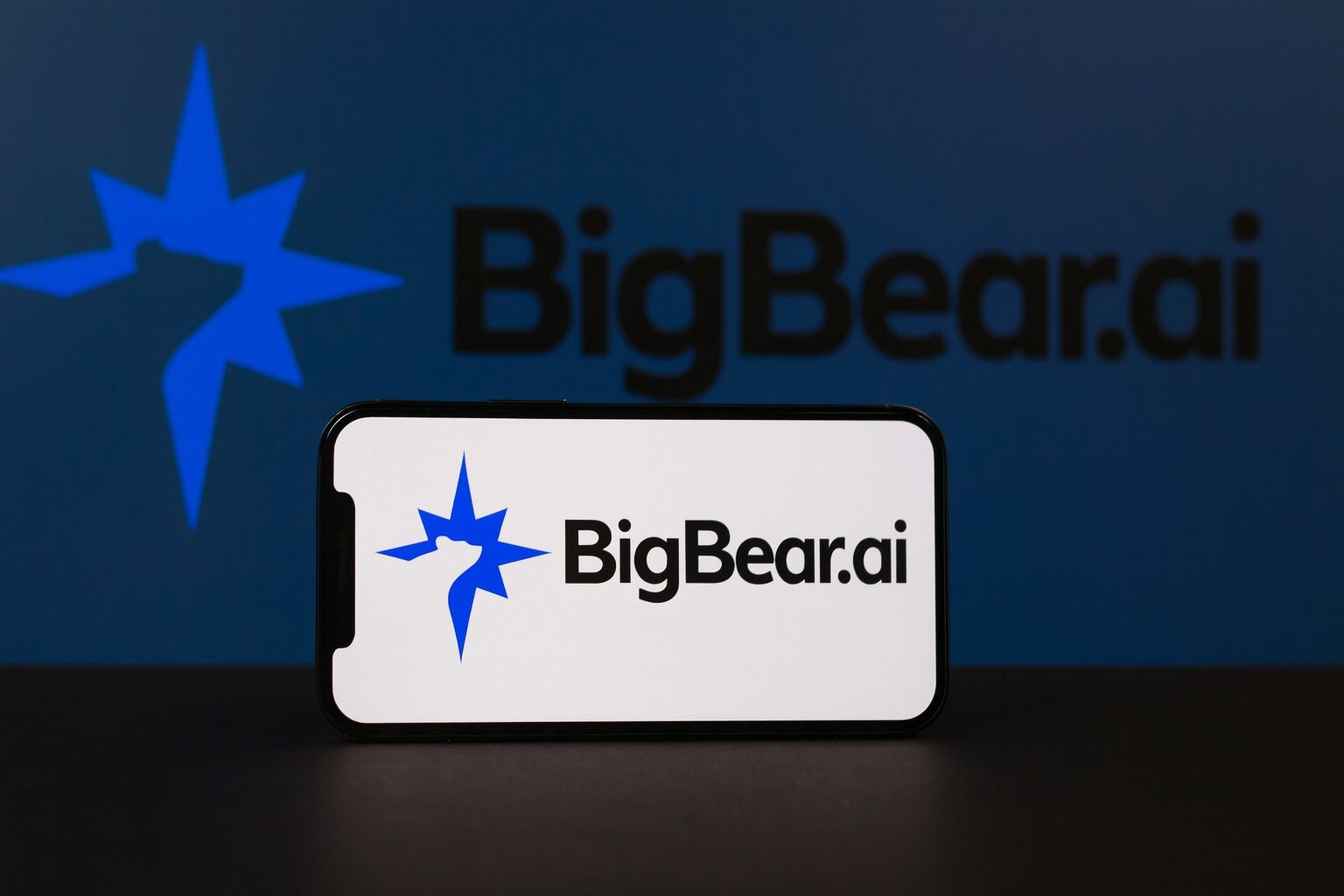- Stock Surge: BigBear.ai Holdings (NYSE: BBAI) shares jumped 22% on Oct. 13 after a new military AI partnership, vaulting the price to around $9 by mid-week [1] [2]. The stock closed at $7.42 on Oct. 17 [3], still up over 100% year-to-date in 2025 [4] but extremely volatile (frequent 10%+ swings on news).
- New Defense Deals: BigBear.ai’s rally is fueled by fresh government AI contracts. On Oct. 13 it unveiled a strategic partnership with Tsecond Inc. to deliver AI-enabled “edge” infrastructure for U.S. national security operations [5]. In late September, BigBear partnered with SMX during the U.S. Navy’s UNITAS 2025 naval exercise to deploy AI-driven maritime surveillance tools on unmanned vessels [6]. The company also recently launched its “veriScan” biometric system at Nashville International Airport, speeding up passport control with facial recognition [7] – expanding BigBear’s profile in defense, homeland security and air travel.
- Financial Picture: Recent earnings highlight growth challenges. Q2 2025 revenue fell 18% year-over-year to $32.5 million, and a one-time charge drove the net loss to $228.6 million [8]. Management slashed full-year 2025 revenue guidance to $125–$140 million (from ~$155M prior) [9] and withdrew EBITDA targets. On the positive side, BigBear ended Q2 with ~$390 million in cash (bolstered by a private placement) and boasts a $380 million contract backlog [10], providing future revenue visibility. (Q3 2025 results are due November 10.)
- Analyst Sentiment:Wall Street is mixed on BBAI despite the recent spike. The consensus rating is Hold with an average 12-month price target around $6 – roughly 20% below the current price [11]. Some bulls are raising targets: for example, H.C. Wainwright reaffirmed a Buy with an $8 target, noting BigBear “could benefit from the new $300B+ ‘One Big Beautiful Bill’ defense/AI budget” Congress is eyeing [12]. However, other analysts caution that at 13× 2025E sales the stock’s valuation looks stretched given ongoing losses [13].
- AI Defense “Mini-Palantir”: BigBear.ai is often dubbed a “mini-Palantir” in the defense analytics arena [14]. Industry leader Palantir (PLTR) – which focuses on similar government AI applications – has soared ~300% in 2025 and trades near $180/share [15], backed by billions in revenue, versus BigBear’s ~$30M quarterly sales. Another peer, C3.ai (NYSE: AI), also chases government AI contracts but has seen slower growth [16]. BigBear’s niche focus and deep government ties are competitive advantages, but its ~25% gross margins pale next to Palantir’s ~80% [17] – underscoring the challenge of scaling profitability in this sector.
Stock Price Soars Amid Defense AI Boom
BigBear.ai’s stock has been on a tear in October as investors pile into defense-focused AI names. On October 13, shares spiked 22% in a single day after the company announced a new AI partnership, leaping from the mid-$7 range to about $8.80 [18]. It was BBAI’s biggest one-day jump in over a year. Heavy trading continued as the rally carried into Oct. 14, when the stock hit an intraday high of $9.39 [19]. By mid-week, BBAI hovered near $9 – more than double its value at the start of 2025 [20].
However, the ride has been volatile. After peaking mid-week, shares pulled back to $7.42 by the Friday, Oct. 17 close [21], as traders likely took profits. Such turbulence is nothing new for BigBear.ai – the stock has a history of wild swings. It traded under $2 late last year but has rocketed roughly 80–100% year-to-date on optimism around AI in defense [22]. BigBear has seen double-digit pops and drops in response to news: for instance, a single Navy contract announcement in late September sent BBAI up 11% in one day [23], while an earnings miss in August triggered a 20% plunge [24]. Technical indicators reflect the speculative fervor (recently the stock’s RSI hit overbought levels, and implied volatility stands around 136%, several times the market average [25]). Bottom line: BigBear.ai’s share price momentum is strong but unstable – expect a bumpy ride as the market digests each new headline.
New AI Partnerships Fueling Optimism
The catalyst behind BigBear.ai’s recent surge is a string of government-focused AI deals that position the company as a rising player in “mission-ready” artificial intelligence. The most prominent is BigBear’s new partnership with Tsecond Inc. announced on October 13. Tsecond is a Silicon Valley defense tech firm known for BRYCK, a rugged edge-computing hardware platform. BigBear.ai will integrate its ConductorOS orchestration software with Tsecond’s BRYCK, creating AI-enabled infrastructure at the tactical edge for U.S. military and intelligence units [26] [27]. The goal is to allow troops to rapidly deploy AI algorithms in the field – processing sensor data and detecting threats in real time even with limited or no cloud connectivity [28] [29].
“Edge AI must be fast, secure, and simple to deploy under pressure,” said BigBear.ai CEO Kevin McAleenan, underscoring the partnership’s importance. “Together with Tsecond as a preferred partner at the tactical edge, we’re equipping national security teams with the ability to process data within seconds, detect threats sooner, and adapt quickly – even in disconnected environments – for decisive action when it matters most.” [30] [31]
This Tsecond alliance showcases BigBear.ai’s push into battlefield AI – a hot area as the Pentagon pours investment into next-gen combat tech. It “marks a pivotal moment in the defense sector” and validates BigBear’s technology in high-stakes environments where speed and reliability are paramount [32]. Investors responded by bidding up BBAI stock on hopes that BigBear could capture a larger slice of defense IT spending.
Importantly, Tsecond isn’t the only recent win on BigBear’s plate. In late September, the company announced a partnership with SMX, a digital solutions provider, to support the U.S. Navy’s major UNITAS 2025 naval exercise [33]. UNITAS is one of the world’s longest-running multinational war games, involving 26 allied nations. During the exercises (held Sept. 15–Oct. 6), BigBear.ai deployed AI-powered sensor fusion and analytics across unmanned vessels and hybrid fleets to help the Navy’s 4th Fleet track illicit trafficking, arms smuggling and other threats in vast maritime zones [34] [35]. BigBear’s technology (including its Arcas™ computer vision system and ConductorOS) integrated data from drones and ships into a unified dashboard, providing commanders with real-time pattern-of-life analysis and predictive insights [36].
After UNITAS, McAleenan noted the project “underscores BigBear.ai’s commitment to equipping U.S. and allied forces with mission-ready AI that delivers real impact where it’s needed most” [37]. In complex maritime environments – where limited resources are stretched across huge areas – BigBear’s AI helped improve situational awareness and decision-making speed, giving operators an edge in combating illegal activities at sea.
Around the same time, BigBear.ai expanded further into homeland security and travel applications. Earlier this month, its veriScan® biometric screening system went live at Nashville International Airport (BNA) as part of a U.S. Customs and Border Protection program [38]. VeriScan uses facial recognition to verify travelers’ identities and expedite passport control. The Nashville pilot allows eligible U.S. citizens to bypass traditional passport checks by simply having their face scanned – significantly speeding up international arrivals [39] [40]. This comes after BigBear’s biometric tech was already adopted for airport boarding at several hubs. Such deployments, beyond the battlefield, demonstrate BigBear.ai’s versatility – spanning military, intelligence, homeland security, and now commercial air travel use cases.
All these new contracts and partnerships are raising BigBear.ai’s profile in the national security tech ecosystem. They also contribute to a growing pipeline of business. BigBear now has footholds in maritime domain awareness, edge AI hardware/software, and biometric security, complementing its existing analytics work for defense clients. These wins build on previous successes – notably, a $165.15 million U.S. Army contract awarded in late 2024 to develop the Army’s Global Force Information Management system [41]. (That five-year deal, BigBear’s largest to date, is a backbone of its backlog.) The company has also worked on international projects, including AI-driven customs inspections in the Middle East and cargo security in Panama [42]. In short, BigBear.ai is steadily assembling a broad portfolio of AI solutions across defense and critical infrastructure, which could unlock follow-on orders if the technology performs as promised.
Financial Challenges Temper the Hype
Despite the exciting contract news, BigBear.ai’s financial results reveal hurdles on the path to profitability. In its most recent earnings (Q2 2025), the company reported $32.5 million in revenue, an 18% drop from the same quarter a year prior [43]. Management attributed the decline largely to disruptions in certain Army programs (a reminder that government project timing can be unpredictable). More alarming was the surge in net loss to $228.6 million for Q2 [44]. This huge loss (versus a $14.4M loss in Q2 2024) was driven by hefty one-time charges – including what analysts believe were impairment write-downs related to prior acquisitions and other non-cash expenses [45]. In other words, BigBear took a big accounting hit, possibly “clearing the decks” of legacy costs.
In response to the weaker revenue trend, BigBear’s leadership cut its full-year 2025 sales guidance to $125–$140 million, down from ~$155M previously [46]. They also suspended prior adjusted EBITDA targets, acknowledging the company will continue operating at a loss in the near term as it invests in growth. Not surprisingly, the disappointing Q2 results in August sent the stock tumbling over 20% in a day [47].
Yet, BigBear insists it is financially well-positioned to execute its strategy. The company raised fresh capital in 2025 (via private placements and possibly government investment), ending Q2 with about $390.8 million in cash on hand [48] – a substantial war chest for a firm of its size. This cash buffer gives BigBear runway to fund R&D, fulfill large contracts (which often incur upfront costs), and absorb ongoing losses for a while. Additionally, BigBear.ai’s total contract backlog has swelled to roughly $380 million [49], a reflection of multi-year agreements like the Army GFIM program and other awards. That backlog figure suggests the company has several years of revenue “booked” (if it can deliver on those contracts).
The challenge now is executing: converting that backlog into revenue efficiently. Thus far, BigBear’s expenses have grown faster than its sales – hence the negative margins. Gross profit margins in Q2 were only ~25%, which is quite low for a software/AI company [50]. Management says newer deals (like Tsecond and SMX) should eventually yield higher-margin, repeatable software revenue, whereas some older contracts were more one-off services. Investors will be watching the upcoming Q3 2025 earnings report (due Nov. 10) for any signs of revenue re-acceleration or cost improvements. With the stock price now reflecting a lot of future growth, BigBear.ai needs to show progress toward profitability to maintain investor confidence. The good news: the U.S. government’s push to fund AI and the company’s recent contract wins could translate into improving financials in 2024 and beyond – if BigBear can manage execution and avoid further program delays.
Analysts Split on BBAI’s Outlook
Amid BigBear.ai’s dramatic rise, expert opinions are divided on whether the stock is a smart bet or an overhyped flyer. According to Bloomberg and TS2, Wall Street coverage on BBAI is limited but lukewarm [51]. Out of a handful of analysts, the consensus rating is “Hold.” As of this week, 2 analysts rate BigBear a Buy, 2 say Hold, and 1 recommends Sell [52]. The average price target is about $5.80–$6.00 per share, which is ~20% below the recent trading price around $7.50–$8 [53]. In short, on paper the stock is already above where analysts think it “should” be in 12 months.
Bulls, however, see more upside – if BigBear executes well. H.C. Wainwright and Cantor Fitzgerald have issued Buy ratings with targets in the $6–$8 range [54]. The bullish thesis: BigBear.ai is emerging as a pure-play on AI defense spending at a time when Washington is poised to unleash enormous budgets for military tech. In fact, Congress is weighing what one analyst dubbed a “One Big Beautiful Bill” – a potential $300+ billion package for defense and AI initiatives – which could trickle down to contracts for companies like BigBear [55]. Supportive analysts argue that BigBear’s ~$380M backlog and deep ties in the defense/intel community position it to ride this wave of federal AI investment [56]. If execution goes smoothly, revenue could ramp up and the stock might have room to run further.
On the other hand, skeptics urge caution. The sole bearish analyst (at Alliance Global Partners) has warned that BigBear’s valuation looks expensive relative to fundamentals – with the company now trading at over 13× its expected 2025 sales and an enterprise value well above 30× 2025E EBITDA (which is actually negative) [57]. They point out that BigBear.ai is still losing money and diluting shareholders (the share count has risen due to capital raises). Moreover, the competitive moat is uncertain: tech giants and major defense contractors are also pouring resources into AI, potentially squeezing smaller players. Execution risk is another concern – much of BigBear’s backlog (and investor hope) rests on projects that are prototypes or early-phase. Delays, scope changes, or performance issues could derail the growth story. The recent volatility is itself cited as a risk: retail traders on forums have flocked to BBAI, and the stock’s surge has been momentum-driven, which could reverse sharply if news disappoints [58]. Indeed, quantitative models that screen for quality and growth have given BigBear low scores (one value-oriented model rated BBAI a “45%” on a 100% scale, failing key metrics for profitability) [59].
In essence, BigBear.ai’s future now hinges on execution. As one analysis by Trefis noted, the company’s path to, say, a $20 stock (another doubling from here) would require flawless delivery on contracts, successful new wins, and improved margins [60]. The ingredients for growth are present – a massive defense AI spending boom, a sizeable backlog, and unique tech partnerships – but investors need proof that BigBear can convert these into sustainable earnings [61]. Any missteps or slower uptake could invite a pullback, given the stock’s big run.
BigBear.ai in the Wider AI Arms Race
BigBear’s story is part of a larger trend in 2025: AI is the new arms race – not just among tech companies, but among nations. The U.S. Department of Defense has made it clear that artificial intelligence and machine learning are critical to maintaining a military edge. From the Pentagon’s Joint All-Domain Command and Control (JADC2) initiative to projects in autonomous weapons, defense spending on AI is surging. Lawmakers have floated dedicating hundreds of billions of dollars to upgrade the military’s tech – hence the “One Big Beautiful Bill” shorthand for expected funding [62]. As a result, companies that specialize in defense AI solutions have been in the market spotlight:
- Palantir Technologies – a BigBear.ai peer often mentioned in the same breath – has seen its stock triple this year on the back of strong government demand for its AI platforms. Palantir’s success illustrates the scale possible in this sector: it delivered over $1 billion in revenue last quarter alone [63], helping drive its valuation to ~$40+ billion. BigBear.ai, by contrast, is much smaller (2025 revenue may be ~$130M). But that also means even mid-sized contract wins can be transformative for BigBear’s growth rate.
- C3.ai (another AI software firm with some defense exposure) had a meteoric rise in 2021 but has struggled to maintain growth. Its slower trajectory is a cautionary tale that hype can outpace reality in the AI space. BigBear.ai will need to differentiate itself and demonstrate tangible results to avoid a similar fate.
- Traditional defense contractors like Lockheed Martin, Raytheon (RTX), and Northrop are also increasingly integrating AI into their systems (often via partnerships or acquisitions of tech firms). This means BigBear could face competition or, conversely, become an acquisition target if a larger contractor wants to bolster its AI capabilities. Some observers have speculated that if BigBear.ai continues to win high-profile contracts, it might draw interest as a buyout candidate given its niche expertise and valuable customer relationships.
For now, BigBear.ai’s leadership is emphasizing its role as a nimble, niche player serving defense and intelligence needs that require quick innovation. “We’re like a mini-Palantir for the DoD,” one executive quipped, highlighting the company’s focus on bespoke AI solutions for missions [64]. That niche focus comes with pros and cons. On one hand, BigBear has carved out a space in critical projects (from Army force management to naval exercises) that big competitors may overlook or are too slow to execute. Its agility and clearances allow it to fill urgent needs for agencies. On the other hand, niche contracts can be one-off and low-margin, as reflected in BigBear’s financials [65]. Scaling up will require turning project-based work into repeatable platforms – something Palantir has done successfully, but which BigBear is just beginning to attempt (e.g. productizing ConductorOS and Arcas).
Looking ahead, the broader market context seems favorable: governments worldwide are pouring money into AI for defense, security, and infrastructure. BigBear.ai is aligned with this macro trend at just the right time. The company’s fate will likely track the outcome of a few key drivers in the coming months: the results of its new partnerships (do Tsecond and SMX lead to follow-on orders?), the performance in upcoming earnings (can revenue re-accelerate and losses narrow?), and any further contract announcements (a big win – or lack thereof – could swing sentiment dramatically).
For investors and observers, BigBear.ai has quickly become one of 2025’s most intriguing small-cap stories – a high-risk, high-reward bet at the intersection of the AI boom and the defense sector. Can this “little AI bear” grow into a big beast on par with Palantir? The next few quarters – and the Pentagon’s budget decisions – will go a long way to answering that question. For now, the company has delivered plenty of headline-grabbing deals and a stock chart straight up to the right. The harder part lies ahead: delivering results that match the hype, and turning today’s promise into sustainable profits in the years to come [66].
Sources: BigBear.ai press releases [67] [68]; TechStock² (TS2.tech) analysis [69] [70]; The Economic Times [71] [72]; TipRanks [73]; Trefis Research [74] [75].
References
1. www.tipranks.com, 2. stockinvest.us, 3. stockinvest.us, 4. ts2.tech, 5. ir.bigbear.ai, 6. ir.bigbear.ai, 7. economictimes.indiatimes.com, 8. ts2.tech, 9. ts2.tech, 10. ts2.tech, 11. ts2.tech, 12. ts2.tech, 13. ts2.tech, 14. ts2.tech, 15. ts2.tech, 16. ts2.tech, 17. ts2.tech, 18. ts2.tech, 19. stockinvest.us, 20. ts2.tech, 21. stockinvest.us, 22. ts2.tech, 23. ts2.tech, 24. ts2.tech, 25. ts2.tech, 26. ir.bigbear.ai, 27. ir.bigbear.ai, 28. www.tipranks.com, 29. www.tipranks.com, 30. ir.bigbear.ai, 31. ir.bigbear.ai, 32. www.trefis.com, 33. ir.bigbear.ai, 34. ir.bigbear.ai, 35. ir.bigbear.ai, 36. ir.bigbear.ai, 37. ir.bigbear.ai, 38. economictimes.indiatimes.com, 39. economictimes.indiatimes.com, 40. ts2.tech, 41. bigbear.ai, 42. economictimes.indiatimes.com, 43. ts2.tech, 44. ts2.tech, 45. ts2.tech, 46. ts2.tech, 47. ts2.tech, 48. economictimes.indiatimes.com, 49. ts2.tech, 50. ts2.tech, 51. ts2.tech, 52. ts2.tech, 53. ts2.tech, 54. ts2.tech, 55. ts2.tech, 56. ts2.tech, 57. ts2.tech, 58. ts2.tech, 59. ts2.tech, 60. www.trefis.com, 61. www.trefis.com, 62. ts2.tech, 63. ts2.tech, 64. ts2.tech, 65. ts2.tech, 66. www.trefis.com, 67. ir.bigbear.ai, 68. ir.bigbear.ai, 69. ts2.tech, 70. ts2.tech, 71. economictimes.indiatimes.com, 72. economictimes.indiatimes.com, 73. www.tipranks.com, 74. www.trefis.com, 75. www.trefis.com










